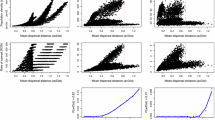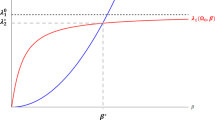Abstract
Many species of invasive insects establish and spread in regions around the world, causing enormous economical and environmental damage, in particular in forests. Some of these insects are subject to an Allee effect whereby the population must surpass a certain threshold in order to establish. Recent studies have examined the possibility of exploiting an Allee effect to improve existing control strategies. Forests and most other ecosystems show natural spatial variation, and human activities frequently increase the degree of spatial heterogeneity. It is therefore imperative to understand how the interplay between this spatial variation and individual movement behavior affects the overall speed of spread of an invasion. To this end, we study an integrodifference equation model in a patchy landscape and with Allee growth dynamics. Movement behavior of individuals varies according to landscape quality. Our study focuses on how the speed of the resulting traveling periodic wave depends on the interaction between landscape fragmentation, patch-dependent dispersal, and Allee population dynamics.












Similar content being viewed by others
References
Blackwood J, Berec L, Yamanaka T, Epanchin-Niell R, Hastings A, Liebhold A (2012) Bioeconomic synergy between tactics for insect eradication in the presence of allee effects. In: Proceedings of the Royal Society of London B, vol 279
Courchamp F, Berec L, Gascoigne J (2009) Allee Effects in Ecology and Conservation. OUP, Oxford
Dewhirst S, Lutscher F (2009) Dispersal in heterogeneous habitats: thresholds, spatial scales, and approximate rates of spread. Ecology 90:1338–1345
Gilbert M, White S, Bullock J, Gaffney E (2014) Spreading speeds for stage structures plant populations in fragmented landscapes. J Theor Biol 349:135–149
Hurford A, Hebblewhite M, Lewis M (2006) A spatially explicit model for an allee effect: why wolves recolonize so slowly in greater yellowstone. Theor Popul Biol 70:244–254
Kanarek A, Webb C, Barfield M, Holt R (2013) Allee effects, aggregation, and invasion success. Theoretical Ecology 6:153–164
Kawasaki K, Shigesada N (2007) An integrodifference model for biological invasions in a periodically fragmented environment. Japan Journal of Industrial and Applied Mathematics 24:3–15
Keitt T, Lewis M, Holt R (2001) Allee effects, invasion pinning, and species’ borders. Am Nat 157(2):203–216
Kot M, Lewis M, van den Driessche P (1996) Dispersal data and the spread of invading organisms. Ecology 77:2027–2042
Kot M, Schaffer WM (1986) Discrete-time growth models. Math Biosci 80:109–136
Lewis M, Kareiva P (1993) Allee dynamics and the spread of invading organisms. Theor Popul Biol 43:219–233
Maciel G, Lutscher F Submitted. Allee effects and population spread in patchy landscapes. J Biol Dyn
Maciel GA, Lutscher F (2013) How how individual movement response to habitat edges affects population persistence and spatial spread. Am Nat. doi:10.1086/670661
Miller T, Shaw A, Inouye B, Neubert M (2011) Sex-biased dispersal and the speed of two-sex invasions. Am Nat 5:549–561
Musgrave J, Lutscher F (2013a) Integrodifference equations in patchy landscapes I. Dispersal kernels. J Math Biol. doi:10.1007/s00285-013-0714-2
Musgrave J, Lutscher F (2013b) Integrodifference equations in patchy landscapes II. Population level consequences. J Math Biol. doi:10.1007/s00285-013-0715-1
Neubert M, Kot M, Lewis M (1995) Dispersal and pattern formation in a discrete-time predatory-prey model. Theor Popul Biol 48:7–43
Ovaskainen O, Cornell SJ (2003) Biased movement at a boundary and conditional occupancy times for diffusion processes. J Appl Probab 40:557–580
Robbins T (2004) Seed dispersal and biological invasions: a mathematical analysis. Ph.D. thesis, University of Utah, Salt Lake City, Utah
Safranyik L, Linton D, Silversides R, McMullen L (1992) Dispersal of released mountain pine beetles under the canopy of a mature lodgepole pine stand. J Appl Entomol 113:441–450
Schultz C, Crone E (2001) Edge-mediated dispersal behavior in a prairie butterfly. Ecology 82(7):1879–1892
Shigesada N, Kawasaki K, Teramoto E (1986) Travelling periodic waves in heterogeneous environments. Theor Popul Biol 30:143–160
Taylor C, Hastings A (2005) Allee effects in biological invasions. Ecol Lett 8:895–908
Tobin P, Berec L, Liebhold A (2011) Exploiting allee effects for managing biological invasions. Ecol Lett 14:615–624
Tobin P, Robinet C, Johnson D, Whitmire S, Bjørnstad O, Liebhold A (2009) The role of allee effects in gypsy moth, Lymantria dispar (l.), invasions. Popul Ecol 51:374–383
Tobin P, Whitmire S, Johnson D, Bjørnstad O, Liebhold A (2007) Invasion speed is affected by geographical variation in the strength of allee effects. Ecol Lett 10:36–43
VanKirk RW, Lewis MA (1997) Integrodifference models for persistence in fragmentated habitats. Bull Math Biol 59:107–137
Veit R, Lewis M (1996) Dispersal, population growth, and the allee effect, dynamics of the house finch invasion of eastern north america. Am Nat 148:83–97
Wang MH, Kot M, Neubert M (2002) Integrodifference equations, allee effects, and invasions. J Math Biol 44:150–168
Weinberger HF (1982) Long-time behavior of a class of biological models. SIAM J Math Anal 13:353–396
Weinberger HF (2002) On spreading speeds and traveling waves for growth and migration models in a periodic habitat. J Math Biol 45:511–548
Acknowledgments
The authors wish to thank Gabriel Maciel for many insightful discussions. JM gratefully acknowledges graduate scholarship from the Natural Science and Engineering Research Council (NSERC) of Canada. AG was partially supported by the work-study program at the University of Ottawa. FL is supported by a Discovery grant from NSERC.
Author information
Authors and Affiliations
Corresponding author
Rights and permissions
About this article
Cite this article
Musgrave, J., Girard, A. & Lutscher, F. Population spread in patchy landscapes under a strong Allee effect. Theor Ecol 8, 313–326 (2015). https://doi.org/10.1007/s12080-015-0252-1
Received:
Accepted:
Published:
Issue Date:
DOI: https://doi.org/10.1007/s12080-015-0252-1




